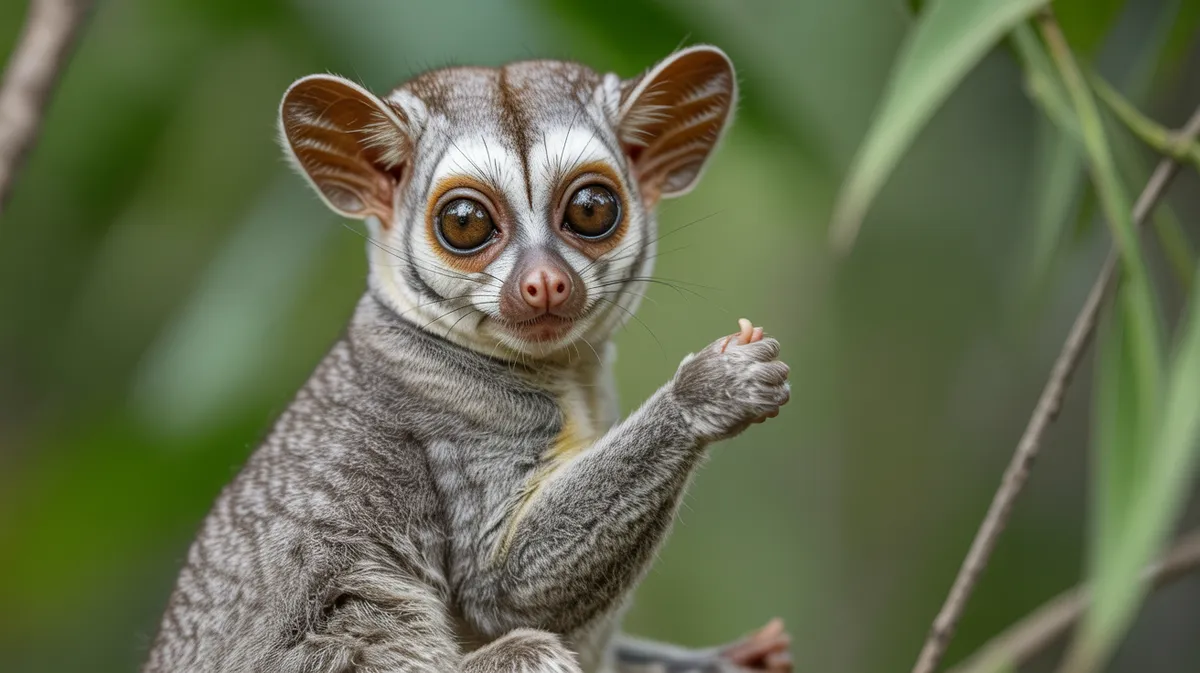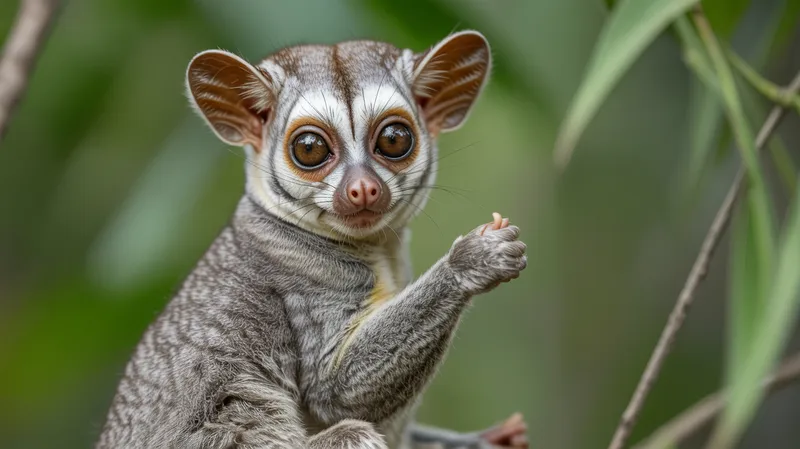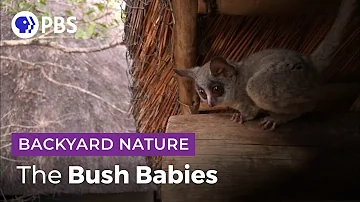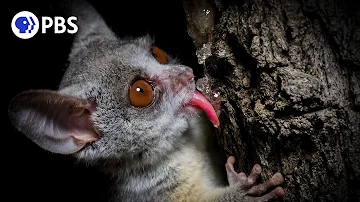
Lesser Bushbaby
Galago senegalensis

Meet the Lesser Bushbaby
The lesser bushbaby, also known as the Senegal bushbaby or Senegal galago, is a small nocturnal primate native to sub-Saharan Africa. It is distinguished by its large, forward-facing eyes adapted for night vision, oversized ears for acute hearing, and long tail. Bushbabies are agile leapers, moving rapidly through trees using powerful hind limbs. They communicate using a range of vocalizations and scent markings, and are highly social, often living in small family groups.
Classification
Mammal
Habitat
Woodlands and savannas
Diet
Omnivore
Lifespan
8-12 years
Conservation
Least Concern
Weight
95-300 grams
📖Fascinating Facts
Night Vision
Bushbabies have enormous eyes relative to their head size, allowing them to see well in low light conditions.
Incredible Jumpers
With powerful hind legs, bushbabies can leap more than 10 times their own body length between tree branches.
Vocal Communicators
Bushbabies produce a variety of sounds, including clicks, whistles, and cries, some of which sound remarkably like a human baby.
📋Detailed Description
The lesser bushbaby (Galago senegalensis), also known as the Senegal bushbaby, is a small, nocturnal strepsirrhine primate native to sub-Saharan Africa. Adults typically weigh between 150 and 300 grams and measure 13–17 cm in body length, with a tail that can reach up to 23–28 cm, aiding in balance during arboreal locomotion. Their fur is dense and woolly, generally grayish to brown on the back and lighter on the underparts, providing camouflage in their woodland and savanna habitats. The species is renowned for its large, forward-facing eyes, which enhance night vision through a reflective tapetum lucidum, and for its mobile, bat-like ears that can independently rotate to pinpoint insect prey. Lesser bushbabies are agile leapers, capable of jumping distances up to 2.25 meters between branches, thanks to their elongated tarsal bones and powerful hindlimbs. Socially, they form loose groups centered around female kin, with males being more solitary and territorial. Communication involves a complex repertoire of vocalizations, including alarm calls, contact calls, and territorial barks, as well as scent marking using urine and glandular secretions. Their diet is omnivorous, consisting of insects, fruit, tree gums, and small vertebrates, with seasonal variation in food preference. Reproduction is seasonal, with females typically giving birth to one or two offspring after a gestation of about 110–120 days. Infants are altricial and initially left in nests or carried in the mother's mouth while she forages.
💡 Did you know?
Bushbabies use their urine to mark their territory and create scent trails for navigation.
🔬Research & Sources
Wikipedia Summary
Lesser bushbabies, or lesser galagos, are strepsirrhine primates of the genus Galago. They are classified, along with the other bushbaby and galago genera in the family Galagidae. They are probably the most numerous primate in Africa, and can be found in every large forest on the continent, inhabiting forested areas, savannas, riverine bush and open woodlands.
Last Modified: 6/1/2025
🎭Behavior & Social Structure
Lesser bushbabies are strictly nocturnal, emerging at dusk to forage and returning to daytime sleeping sites in tree hollows, dense foliage, or constructed nests. Their foraging behavior is characterized by rapid, bounding leaps between branches, often pausing to scan for prey or fruit. They primarily hunt insects, such as moths, beetles, and grasshoppers, using acute hearing to detect movement. Gums and saps from Acacia and other trees are important dietary staples, especially during dry seasons when insects are scarce. Social interactions are most frequent among females and their offspring, who share sleeping sites and engage in mutual grooming. Males maintain overlapping territories with multiple females but are less social, often marking boundaries with urine and secretions from chest and anogenital glands. Vocal communication is highly developed, with over 18 distinct calls documented, including 'clicks,' 'whistles,' and 'screams' used for contact, alarm, and mating. Daily routines involve periods of intense activity interspersed with rest, and individuals may travel up to 1–2 kilometers per night in search of food.
👶Reproduction & Life Cycle
Breeding in Galago senegalensis is typically seasonal, coinciding with the onset of the rainy season when food is abundant. Females exhibit estrus once or twice per year, and mating is often preceded by vocalizations and scent-marking displays. After successful copulation, gestation lasts approximately 110–120 days. Females usually give birth to one or two young, though triplets are rare. Newborns are altricial, with closed eyes and sparse fur, and are initially left in nests or carried by the mother in her mouth. Maternal care is intensive, with nursing lasting up to six weeks and weaning completed by three to four months. Males do not participate in parental care. Juveniles reach sexual maturity at about 8–12 months, with females often remaining in their natal area while males disperse to establish new territories.
🛡️Adaptations & Survival
Lesser bushbabies possess several adaptations for nocturnal and arboreal life. Their large eyes, equipped with a tapetum lucidum, maximize light capture for enhanced night vision. Highly mobile, cup-shaped ears provide acute directional hearing, crucial for detecting prey and predators in dense foliage. The elongated tarsal bones and powerful hindlimbs enable extraordinary leaping ability, allowing them to traverse gaps between trees efficiently. Their hands and feet have opposable thumbs and toes, with flattened nails (except for a grooming claw on the second toe), facilitating strong grip and precise manipulation of food. The tongue is adapted for gouging tree bark to access gum, and their dentition includes specialized lower incisors forming a 'toothcomb' used for grooming and feeding. Behavioral adaptations include the use of urine washing for scent marking and communication, and the construction of nests or use of tree hollows for shelter.
📚Research Sources
🎨Cultural Significance
Lesser bushbabies feature in various African folklores and local beliefs, often associated with mysterious nocturnal calls and elusive behavior. In some cultures, their cries are believed to be omens or to have supernatural significance. The species is sometimes kept as an exotic pet, though this is discouraged due to welfare and conservation concerns. Traditional uses are limited, but bushbabies may be referenced in stories as symbols of agility, cleverness, or the spirit world. Their presence in local ecosystems is sometimes appreciated for controlling insect populations.
🔬Recent Research & Discoveries
Recent research has focused on the vocal communication and social structure of Galago senegalensis, revealing a complex system of calls and scent marking that facilitates group cohesion and territory maintenance. Genetic studies have clarified the taxonomy within the genus Galago, leading to the identification of cryptic species and a better understanding of evolutionary relationships. Ongoing field studies are examining the impact of habitat fragmentation on movement patterns and genetic diversity. Advances in bioacoustics have enabled researchers to monitor populations using automated recording devices, aiding in conservation assessments. Studies on dietary flexibility have highlighted the species' ability to exploit a wide range of food resources, contributing to its ecological success.
🎥Wildlife Videos

Bushbaby Risks it All For First Taste Of Banana | Big Little Journeys | BBC Earth
This bushbaby has spotted some food he has never come across before, but it's in hostile territory… Subscribe: ...
BBC Earth

Bush Baby Tenants | Backyard Nature
You think your upstairs neighbors are noisy? You haven't met these cute, nocturnal creatures living in the South African home of ...
Nature on PBS

Galago 🐒 One Of The Rarest Animals In The Wild - Bush Baby
Galagos, also known as bushbabies, are small primates native to sub-Saharan Africa. They are one of the rarest animals in the ...
1 Minute Animals

How Nocturnal Bush Babies Survive at Night
This young bush baby learned from his mother where to find an important winter food: acacia gum. Please LIKE and SUBSCRIBE ...
Nature on PBS

A Greater Galago (bushbaby) | Phinda Private Game Reserve | andBeyond Night Eye
A greater galago (bushbaby) peacefully goes about its business as guest observe its behaviour undisturbed. Often greater ...
andBeyond

Rescued Bush Baby
A simple act of kindness and compassion towards a single animal may not mean anything to all creatures, but will mean ...
Wild Heart Wildlife Foundation
🌍Habitat Information
The Lesser Bushbaby typically inhabits Woodlands and savannas environments. Lesser Bushbabys have adapted to their environments with specialized features and behaviors.
Primary Habitat:
Woodlands and savannas
More detailed habitat information will be available soon.
🛡️Conservation Status
The Lesser Bushbaby is currently classified as Least Concern. Conservation efforts are crucial for preserving this species for future generations.
Common Threats:
- 🏠Habitat loss and fragmentation
- 🌡️Climate change impacts
- 🎯Hunting and poaching
- 🏭Human-wildlife conflict
⚠️Threats & Conservation Challenges
While Galago senegalensis is currently classified as Least Concern by the IUCN due to its wide distribution and presumed large population, it faces localized threats. Habitat loss from deforestation, agricultural expansion, and urbanization reduces suitable living areas and fragments populations. In some regions, bushbabies are hunted for bushmeat or captured for the pet trade, although this is less common than for larger primates. Predation by owls, snakes, genets, and other carnivores is a natural threat. Climate change may alter the availability of key food resources, such as insects and tree gums, potentially impacting reproductive success. Despite these challenges, the species' adaptability to secondary forests and even human-altered landscapes contributes to its resilience.
🔬Scientific Classification
Scientific Name
Galago senegalensis
Classification Hierarchy
🔍 About Taxonomic Classification
Taxonomic classification is a hierarchical system used by scientists to classify and organize living organisms based on shared characteristics and evolutionary relationships.
The system moves from broad categories (Kingdom) to increasingly specific ones, with each animal's scientific name typically consisting of its Genus and species.
📝Community Notes
Share your observations and insights about the Lesser Bushbaby with our community of wildlife enthusiasts.
Join Our Community
Sign in to share your observations and connect with fellow wildlife enthusiasts.
Sign In to ContributeNo community notes yet
Be the first to share your observations about the Lesser Bushbaby!
Explore Lesser Bushbaby
Select a tab above to learn more about this amazing animal.
📸Photo Gallery
No photos available for this animal yet.
🌟Discover More Wildlife
Continue your journey of discovery with more fascinating animals from our database
